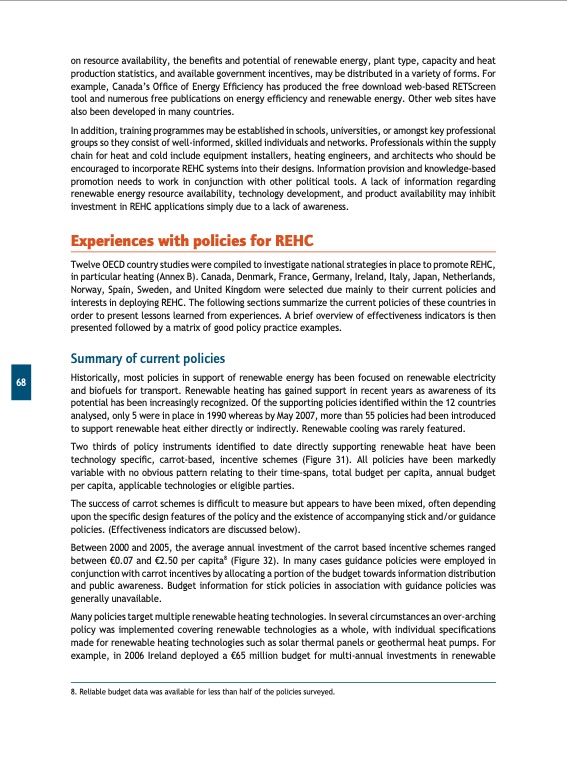
PDF Publication Title:
Text from PDF Page: 070
68 on resource availability, the benefits and potential of renewable energy, plant type, capacity and heat production statistics, and available government incentives, may be distributed in a variety of forms. For example, Canada’s Office of Energy Efficiency has produced the free download web-based RETScreen tool and numerous free publications on energy efficiency and renewable energy. Other web sites have also been developed in many countries. In addition, training programmes may be established in schools, universities, or amongst key professional groups so they consist of well-informed, skilled individuals and networks. Professionals within the supply chain for heat and cold include equipment installers, heating engineers, and architects who should be encouraged to incorporate REHC systems into their designs. Information provision and knowledge-based promotion needs to work in conjunction with other political tools. A lack of information regarding renewable energy resource availability, technology development, and product availability may inhibit investment in REHC applications simply due to a lack of awareness. Experiences with policies for REHC Twelve OECD country studies were compiled to investigate national strategies in place to promote REHC, in particular heating (Annex B). Canada, Denmark, France, Germany, Ireland, Italy, Japan, Netherlands, Norway, Spain, Sweden, and United Kingdom were selected due mainly to their current policies and interests in deploying REHC. The following sections summarize the current policies of these countries in order to present lessons learned from experiences. A brief overview of effectiveness indicators is then presented followed by a matrix of good policy practice examples. Summary of current policies Historically, most policies in support of renewable energy has been focused on renewable electricity and biofuels for transport. Renewable heating has gained support in recent years as awareness of its potential has been increasingly recognized. Of the supporting policies identified within the 12 countries analysed, only 5 were in place in 1990 whereas by May 2007, more than 55 policies had been introduced to support renewable heat either directly or indirectly. Renewable cooling was rarely featured. Two thirds of policy instruments identified to date directly supporting renewable heat have been technology specific, carrot-based, incentive schemes (Figure 31). All policies have been markedly variable with no obvious pattern relating to their time-spans, total budget per capita, annual budget per capita, applicable technologies or eligible parties. The success of carrot schemes is difficult to measure but appears to have been mixed, often depending upon the specific design features of the policy and the existence of accompanying stick and/or guidance policies. (Effectiveness indicators are discussed below). Between 2000 and 2005, the average annual investment of the carrot based incentive schemes ranged between €0.07 and €2.50 per capita8 (Figure 32). In many cases guidance policies were employed in conjunction with carrot incentives by allocating a portion of the budget towards information distribution and public awareness. Budget information for stick policies in association with guidance policies was generally unavailable. Many policies target multiple renewable heating technologies. In several circumstances an over-arching policy was implemented covering renewable technologies as a whole, with individual specifications made for renewable heating technologies such as solar thermal panels or geothermal heat pumps. For example, in 2006 Ireland deployed a €65 million budget for multi-annual investments in renewable 8. Reliable budget data was available for less than half of the policies surveyed.PDF Image | RENEWABLES FOR HEATING AND COOLING

PDF Search Title:
RENEWABLES FOR HEATING AND COOLINGOriginal File Name Searched:
renewable_heating_cooling_final_web.pdfDIY PDF Search: Google It | Yahoo | Bing
NFT (Non Fungible Token): Buy our tech, design, development or system NFT and become part of our tech NFT network... More Info
IT XR Project Redstone NFT Available for Sale: NFT for high tech turbine design with one part 3D printed counter-rotating energy turbine. Be part of the future with this NFT. Can be bought and sold but only one design NFT exists. Royalties go to the developer (Infinity) to keep enhancing design and applications... More Info
Infinity Turbine IT XR Project Redstone Design: NFT for sale... NFT for high tech turbine design with one part 3D printed counter-rotating energy turbine. Includes all rights to this turbine design, including license for Fluid Handling Block I and II for the turbine assembly and housing. The NFT includes the blueprints (cad/cam), revenue streams, and all future development of the IT XR Project Redstone... More Info
Infinity Turbine ROT Radial Outflow Turbine 24 Design and Worldwide Rights: NFT for sale... NFT for the ROT 24 energy turbine. Be part of the future with this NFT. This design can be bought and sold but only one design NFT exists. You may manufacture the unit, or get the revenues from its sale from Infinity Turbine. Royalties go to the developer (Infinity) to keep enhancing design and applications... More Info
Infinity Supercritical CO2 10 Liter Extractor Design and Worldwide Rights: The Infinity Supercritical 10L CO2 extractor is for botanical oil extraction, which is rich in terpenes and can produce shelf ready full spectrum oil. With over 5 years of development, this industry leader mature extractor machine has been sold since 2015 and is part of many profitable businesses. The process can also be used for electrowinning, e-waste recycling, and lithium battery recycling, gold mining electronic wastes, precious metals. CO2 can also be used in a reverse fuel cell with nafion to make a gas-to-liquids fuel, such as methanol, ethanol and butanol or ethylene. Supercritical CO2 has also been used for treating nafion to make it more effective catalyst. This NFT is for the purchase of worldwide rights which includes the design. More Info
NFT (Non Fungible Token): Buy our tech, design, development or system NFT and become part of our tech NFT network... More Info
Infinity Turbine Products: Special for this month, any plans are $10,000 for complete Cad/Cam blueprints. License is for one build. Try before you buy a production license. May pay by Bitcoin or other Crypto. Products Page... More Info
| CONTACT TEL: 608-238-6001 Email: greg@infinityturbine.com | RSS | AMP |